Discover the Dune Costiere Natural Park: Dunes, Beaches, and Ecosystems in Puglia
Updated at: 19-09-2024
How this content can help you:
- You will get to know the Coastal Dune Park: location and characteristics.
- You will understand the importance of coastal dunes in the ecosystem.
- You will discover how to reach the park from various locations.
- You will explore the trails: easy, moderate, and difficult.
- You will visit underground oil mills, "lame," and the Dolmen of Montalbano.
- You will get to know the typical flora and fauna of the park.
- You will discover beaches such as Lido Morelli and Torre Canne.
- You will understand the origin of the volcanic black sand.
- You will learn about the importance of park conservation.
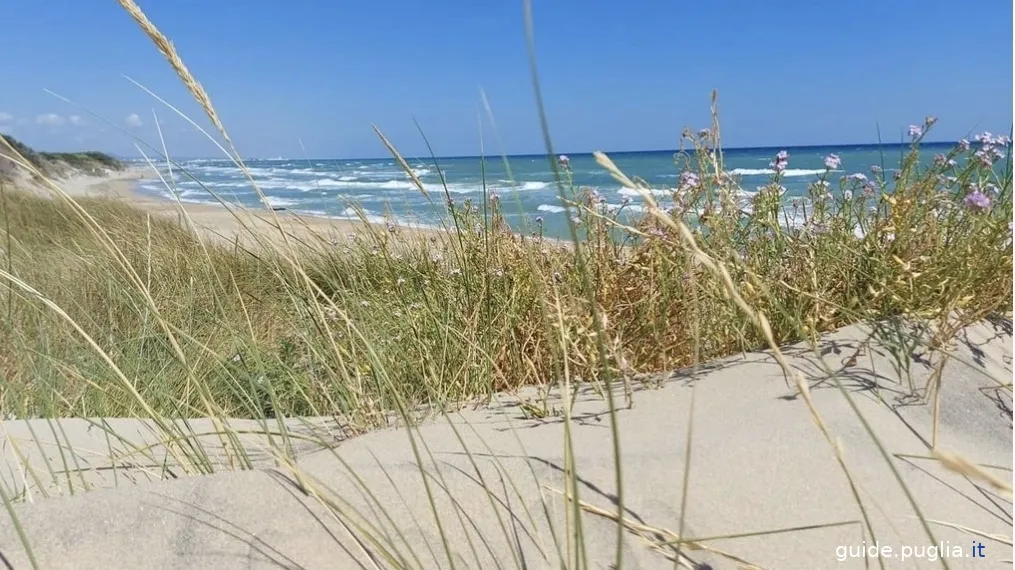
What are Coastal Dunes?
Coastal dunes are natural geological formations consisting of accumulations of sand that develop along coastlines, usually near the sea. These formations are created through the action of the wind, which transports and deposits sand onto the land, where it accumulates and forms hills or ridges of dunes.
The Regional Natural Park of the Coastal Dunes is a protected area located in Puglia, Italy. It covers a stretch of approximately 8 kilometers from Torre Canne to Torre San Leonardo and extends over about 1,000 hectares.
The park is characterized by a varied landscape that includes coastal dunes, Mediterranean scrub, and wetlands, and is an important conservation area for local flora and fauna.
The park is traversed by the Morelli River. This watercourse winds through the park, contributing to the diversity of natural habitats in the area.
How to Reach the Coastal Dunes Park
The park is easily accessible from various locations:
From Brindisi: The park is about 20-30 minutes by car. You need to take the SS16 (Strada Statale 16) heading north and then follow the signs to Carovigno and Ostuni.
From Ostuni: The park is located a few kilometers south of Ostuni. You can reach the area via local roads connecting Ostuni with the coastal areas of the park.
From Bari: If coming from Bari, the park is about 1-1.5 hours by car. Take the SS16 south and follow the signs to Carovigno and Ostuni.
The Coastal Dunes Park is accessible through various entrances located at strategic points along the park's perimeter. Each entrance may offer a different experience and access to specific areas of the park.
The roads leading to the main entrances of the park are generally well-maintained and easily navigable by car. For those using public transportation, combinations of buses and taxis may be necessary, depending on the starting location.
Coastal Dunes: What They Are and Their Importance
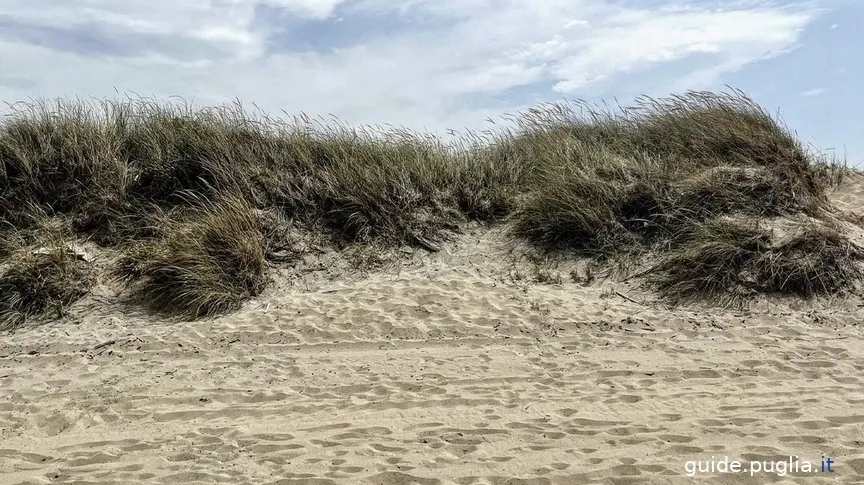
Coastal dunes are fascinating natural formations that develop along beaches, where wind-blown sand accumulates, creating sand hills observable along coastlines. These sandy elevations not only enrich the coastal landscape but also play crucial roles for the environment and our safety.
The Importance of Coastal Dunes
Coastal dunes are essential for several reasons:
Coastal Protection: Dunes act as a natural shield against coastal erosion and the influence of high tides. They serve as a barrier that absorbs wave energy and reduces the impact of flooding, thereby protecting inland areas and coastal infrastructure from erosion and damage caused by the sea.
Unique Habitat: These environments host specialized flora and fauna. Plants like ammofila and rosemary are well adapted to the sandy and windy conditions of dunes, providing shelter and food to a variety of animals, including insects and birds. Dunes can also be home to rare or threatened species, offering them a safe refuge.
Environmental Regulation: Dunes help maintain the ecological balance of the coastal area. Plants growing on dunes can improve air and water quality by trapping dust and pollutants, thus contributing to a healthier environment.
Aesthetic and Recreational Value: Coastal dunes enrich the natural landscape with unique shapes and colors, offering spaces for walks, hikes, and nature observation. This not only enhances the visitor experience but also supports local tourism activities in a sustainable way.
Why It Is Essential to Protect Coastal Dunes
Coastal dunes play a crucial role in our environment, and their protection is vital to preserving the ecological benefits they offer. However, these natural formations are vulnerable to various threats, primarily due to human activities and climate change.
Coastal Development represents one of the main threats to dunes. Building structures and infrastructure along the coast can irreparably damage these sandy formations, reducing their ability to protect inland areas from erosion and high tides. Artificial structures can disrupt the natural balance of dunes, compromising their effectiveness in maintaining coastal stability.
Water and soil pollution also significantly impacts coastal dunes. When soil and water quality deteriorates due to pollutants, the plants stabilizing the dunes suffer. These changes reduce the plants' ability to retain sand, thereby compromising the habitat quality for animals that find refuge there.
Unregulated recreational activities and tourism can further damage dunes. Practices like trampling and uncontrolled access can destroy dune vegetation and alter their structure. This type of activity not only reduces the dunes' ability to provide natural protection but can also disturb the habitats of local animals that depend on these environments for survival.
Finally, climate change represents a growing threat. Rising sea levels and changes in weather patterns can accelerate dune erosion and negatively affect their ecological balance. These climate changes can alter the formation and stability of dunes, putting at risk their ability to protect the coast and support the flora and fauna living there.
Trails in the Coastal Dunes Natural Park
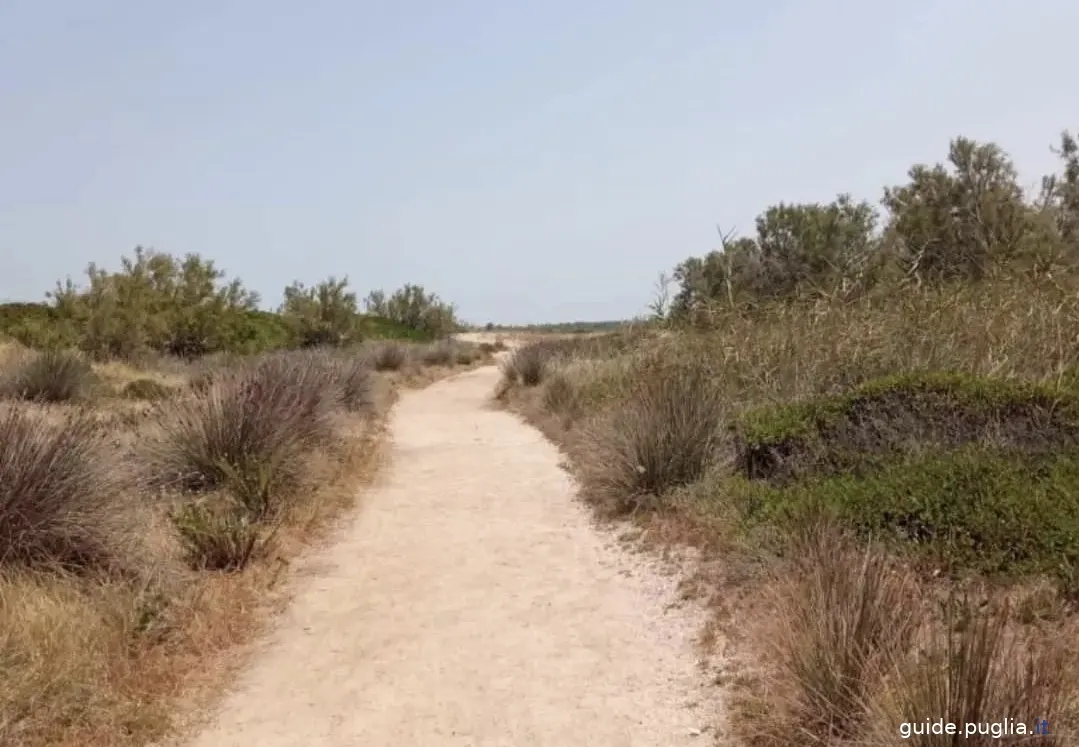
The Coastal Dunes Natural Park offers a variety of trails and paths suitable for different levels of experience and physical ability, making the visit a rich and varied experience for all types of hikers.
Easy Trails
For those looking for a relaxed and uncomplicated hike, the park offers easy trails, ideal for families with children and those with reduced mobility. These trails are generally flat and well-maintained, with even surfaces that facilitate walking.
Walking along these trails, you'll have the opportunity to explore the beautiful coastal dunes, observe dune flora, and immerse yourself in the Mediterranean scrub.
You’ll be able to admire plants adapted to sandy and windy conditions, and, if you're lucky, you might spot some of the coastal birds that inhabit the area.
An example of these trails is the Dune Trail, which winds along the coast, offering spectacular sea views and resting areas to enjoy the landscape.
Moderate Trails
If you're a hiker in good physical condition but not looking for too challenging a path, the moderate trails are perfect for you.
These trails may include slightly hilly sections and uneven terrain. Walking along these paths will allow you to discover the park's rich forest vegetation, with oak forests and trees typical of the Apulian hinterland.
Some trails pass near wetlands and ponds, where you can observe aquatic flora and spot migratory birds. You may also encounter historical remains, such as ancient farmhouses or lookout towers.
An example of a moderate trail is the Forests and Ruins Trail, which guides you through wooded areas and leads to interesting historical sites.
Difficult Trails
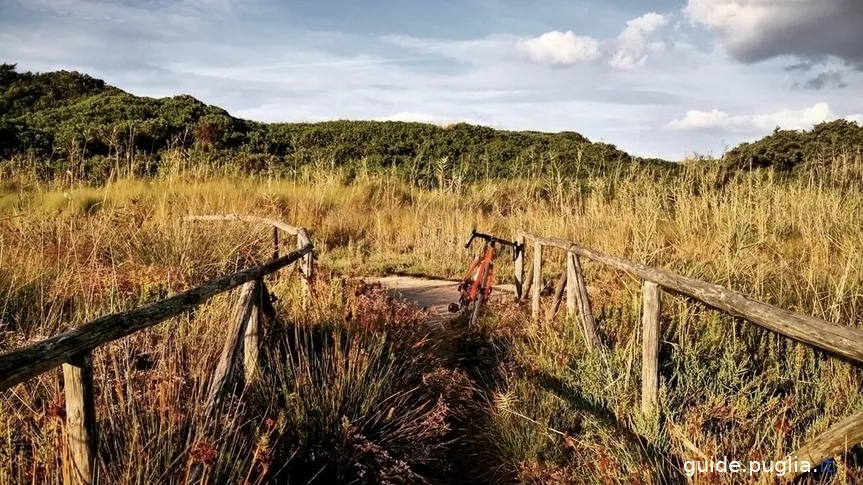
For more experienced and adventurous hikers, the park offers more challenging trails. These routes feature hilly sections, steep slopes, and uneven surfaces, and require appropriate physical preparation and, in some cases, hiking equipment.
Walking on these trails will give you the opportunity to experience spectacular views, with breathtaking vistas of the sea horizon and the surrounding landscape. You can explore diverse natural landscapes, passing through coastal dunes, forests, and hilly areas.
In these areas, you’ll also have the chance to observe rare plant and animal species that inhabit less accessible environments.
The Hills Trail, for example, leads you through the inland hills, offering panoramic views and the opportunity to explore more pristine corners of the park.
Signage and Maps
Trail signage is well-maintained, with markers and informational signs providing useful details about trail length, estimated time, and trail features.
However, for safer navigation, it is always advisable to carry a detailed map or use a GPS navigation app. Maps can be obtained at the park’s information points or downloaded from the official website, and will help you orient yourself and follow the correct routes.
What to See in the Park?
Underground Olive Mills
The underground olive mills are one of the distinctive cultural and historical aspects of the Coastal Dunes Natural Park. These ancient subterranean mills are an important part of Apulia’s agricultural heritage and offer a glimpse into the tradition of olive oil production in the region.
Underground mills are structures used for pressing olives and producing olive oil. The term "hypogeum" comes from Greek and means "underground," referring to their location beneath the ground or semi-buried. These mills were carved into tuff, a soft limestone typical of the region, and represent a fascinating example of traditional rural architecture.
Underground mills often consist of a series of interconnected rooms, including areas for pressing olives, collecting, and storing oil. They are primarily built from tuff and limestone, materials that ensure good ventilation and maintain the ideal temperature for storing oil.
These underground mills are a significant part of Apulia’s agricultural tradition and are witnesses to oil production techniques dating back centuries.
The Lame
Lame are geological formations typical of the Apulian region, created by fluvial erosion. These valleys, often U-shaped or V-shaped, are the result of millennia of shaping by rainwater and streams.
These valleys were carved over time by the erosive action of water, which cut channels into the calcareous and tuffaceous soil. The effect of this process is visible in the deep canyons and undulations of the landscape.
The lame host a varied vegetation, ranging from Mediterranean scrublands to denser woods. This environment provides shelter and resources for a wide variety of flora and fauna. In some areas, you may find small caves or grottos formed by rock erosion, which offer refuge to various species and can be interesting for exploration.
The Dolmen of Montalbano
The Dolmen of Montalbano is an ancient megalithic monument located in the Coastal Dunes Natural Park, dating back to the Neolithic period, around 3000 B.C. This period is characterized by the introduction of agriculture and the beginning of megalithic constructions in various parts of Europe.
The dolmen consists of a series of vertically erected stone slabs covered by a horizontal slab, creating a type of chamber tomb. This structure was used for burying the deceased and is often associated with rituals and religious beliefs.
Some dolmens feature decorations or carvings on the stones, which may include geometric or symbolic patterns. However, the Dolmen of Montalbano is relatively simple and does not display complex ornaments, which is common for dolmens of this era.
The Dolmen of Montalbano is accessible to visitors via paths within the park. These paths are designed to allow exploration without damaging the site.
Flora and Fauna
The Coastal Dunes Natural Park is a true treasure trove of biodiversity, where flora and fauna create a mosaic of life and natural beauty. As you walk along its trails and beaches, you'll have the opportunity to discover a rich variety of plants and animals that inhabit this fascinating corner of the Adriatic coast.
Flora of the Park

Starting with the dune plants, which are crucial for stabilizing sandy soil. Among these, ammophila is particularly important: its deep roots anchor the sand and prevent erosion. Next to it, the cistus with its colorful flowers adds a touch of vibrancy to the landscape.
In the Mediterranean scrub forests, you can find rosemary, with its aromatic scent characterizing the area, and juniper, which grows in drier and rockier areas. These shrubs are well adapted to the region's drought and windy conditions.
The park’s wetlands host plants such as carex, which help stabilize the soil and maintain aquatic ecosystem balance. The common reed, with its vibrant flowers, can also be found in marshy areas.
Finally, among the park’s trees and shrubs, the Aleppo pine stands out, forming forests in Mediterranean areas, and the holm oak, an evergreen oak that is an essential component of Mediterranean scrub.
Fauna of the Park
The park’s fauna is equally captivating. Among birds, you can spot the peregrine falcon, known for its speed and hunting skills, and the little ringed plover, a small coastal bird that nests on sandy beaches. It is also not uncommon to see the knight of Italy, elegant with its long legs and slender beak, frequenting the park’s wetlands and marshes.
Among insects, dragonflies and damselflies are particularly striking with their bright colors and graceful flight over the wetlands. In summer, you might also notice some dune butterflies, like the Vanessa cardui and Zerynthia polyxena, fluttering among the scrubland plants.
Among mammals, the fox and the wild boar are among the most representative. The fox, agile and furtive, is often seen in the woods and scrub areas, while the wild boar frequents the forested and wet areas, though it might be less visible during the day.
Amphibians like the green frog thrive in the park’s wetlands, while the lizard hides among the bushes and woods.
Finally, in the coastal waters, you can observe various marine fish, such as bream and sea bass, swimming in the shallow waters. Additionally, crabs, sea urchins, and mollusks inhabit the intertidal zones along the coast.
Beaches of the Coastal Dunes Natural Park
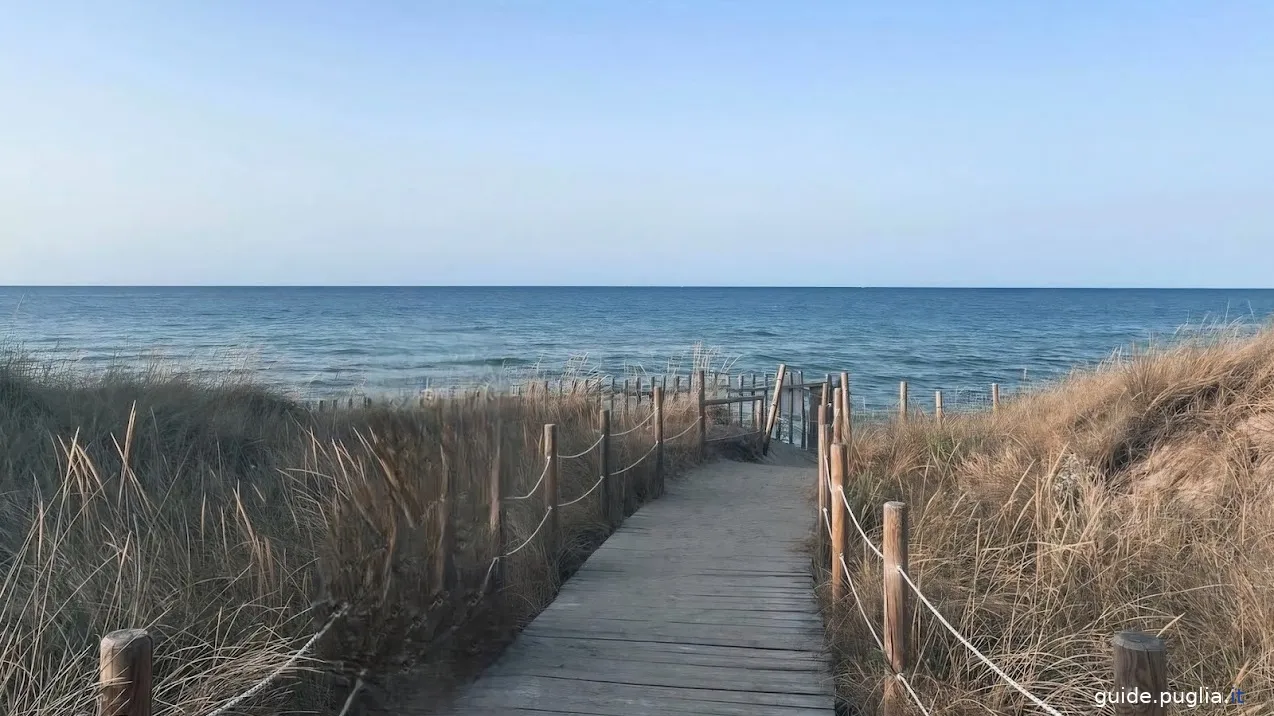
Torre Canne Beach
Located in the southern part of the park, Torre Canne is one of the most well-known beaches in the area. It features a long stretch of sand and crystal-clear waters, surrounded by coastal dunes and Mediterranean vegetation.
This sandy expanse offers ample space for relaxation and beach activities, making it ideal for families and groups of friends.
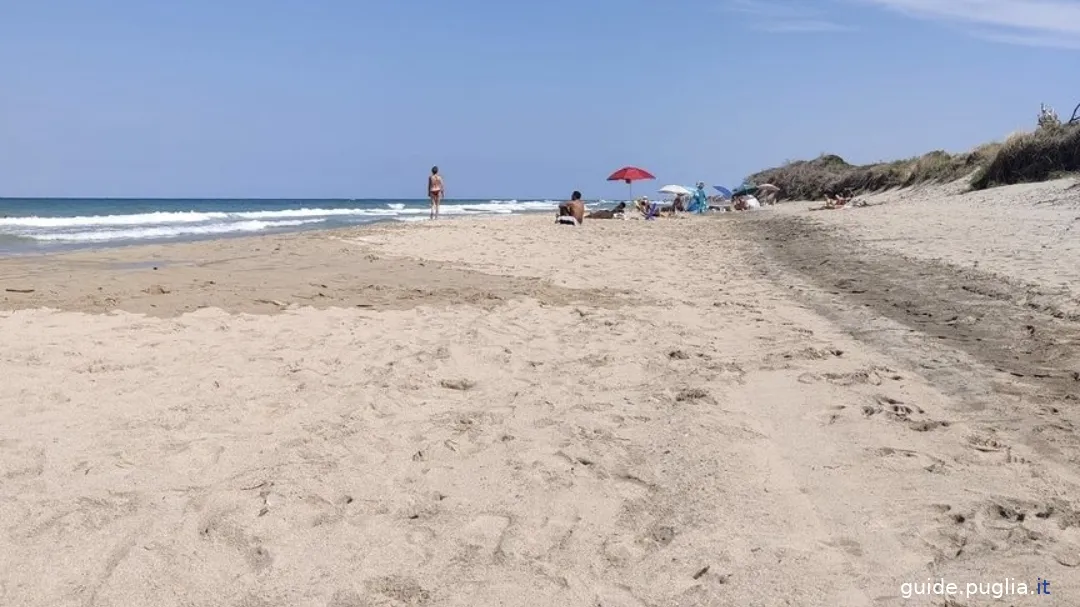
It is a well-preserved beach, with regulated access to preserve the natural environment.
One of the distinctive elements of the area is the Torre Canne Lighthouse, located near the beach. The lighthouse, built in the 19th century, offers panoramic views of the coast and adds a historical touch to the landscape.
Lido Morelli Beach

Lido Morelli Beach is one of the gems of the Coastal Dunes Natural Park, located in the central part of the park. This stretch of coast is characterized by fine sand and clear waters, surrounded by sand dunes and Mediterranean vegetation that create a tranquil and picturesque environment. The beach, less crowded compared to other locations, offers an ideal refuge for those seeking serenity and direct contact with nature.
Nearby, the Morelli River flows not far from Lido Morelli Beach. This short river flows into the sea right near the beach. The river’s waters positively influence the ecosystem of the dunes and surrounding wetlands, contributing to the biodiversity and maintenance of the natural environment of the beach.
Lido Piccolo Beach
Located near Lido Morelli, Lido Piccolo is a small beach offering a tranquil and natural environment. It features clear waters and typical coastal dune vegetation.
Like the other beaches in the park, it is accessible via paths designed to reduce foot traffic and protect the ecosystem.
Black Sand in the Coastal Dunes Natural Park
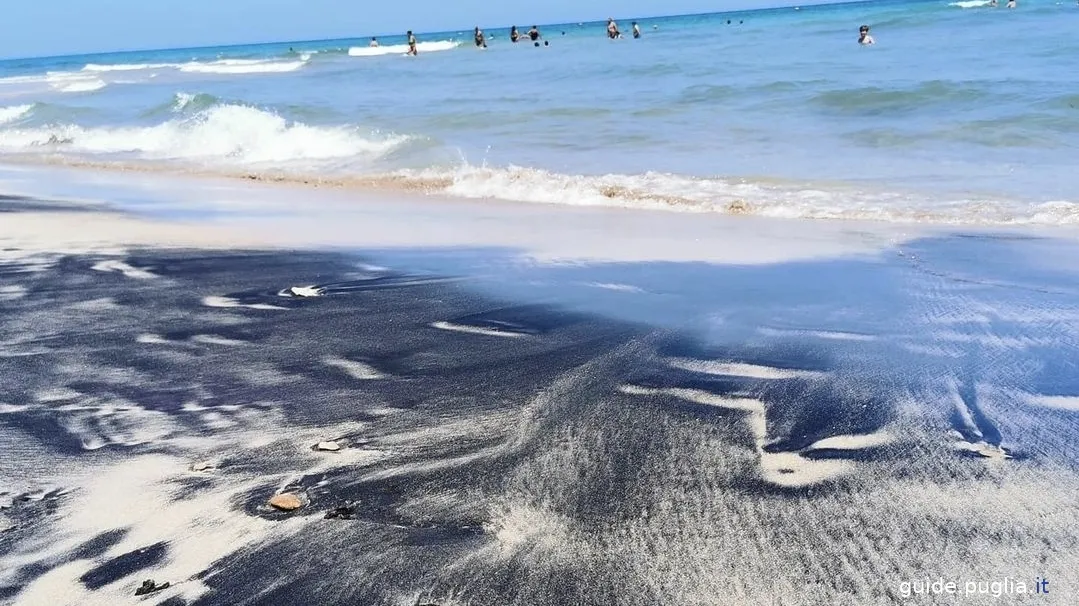
The black sand found on some beaches in the park originates from the Vulture Volcano, an ancient volcano located in the Apulian hinterland. This volcano, which was highly active during the Neogene, produced a variety of volcanic rocks and minerals, such as basanite and obsidian. Over millennia, these rocks have been eroded and crushed, creating sediments that have been transported to the coast.
The Ofanto River, which flows through the region, plays a crucial role in this process. The river’s waters collect and transport volcanic sediments from the Vulture to the coastal area. Once reaching the sea, the river releases these materials, which are then distributed along the beaches by the force of the ocean currents.
The black sand deposited along the park’s beaches is composed of dark minerals and fragments of volcanic rocks.
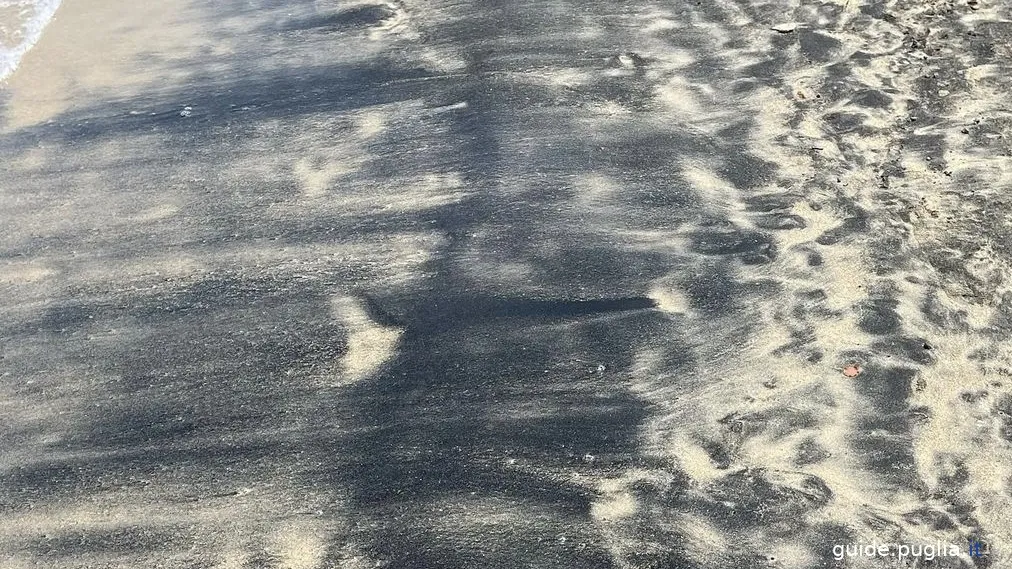
This gives the sand a distinctive color, quite different from the light sand that characterizes most Apulian beaches. The dark color not only provides a fascinating visual contrast but also reflects the unique geological composition of the region.
Its presence offers a glimpse into the geological processes that took place in ancient times and how these have influenced the current environment. Additionally, black sand enriches the park’s biodiversity, creating unique habitats for some species of flora and fauna adapted to these particular conditions.
Conclusions
The Coastal Dunes Natural Park represents a corner of extraordinary beauty and biodiversity along the Adriatic coast of Apulia. This park offers an exceptional combination of natural landscapes, with its sand dunes, pristine beaches, and a rich variety of ecosystems ranging from wetlands to Mediterranean scrubland.
The protection and enhancement of this park are crucial not only for conserving local flora and fauna but also for ensuring that future generations can enjoy the beauty and tranquility of these natural environments.
Beaches, such as Lido Morelli, with their fine sand and crystal-clear waters, offer a serene refuge away from the hustle and bustle of more touristy locations.
Moreover, the presence of watercourses like the Morelli River and the distinctive underground mills and rock settlements enriches the historical and cultural heritage of the park, providing a fascinating insight into the history and evolution of the land.
